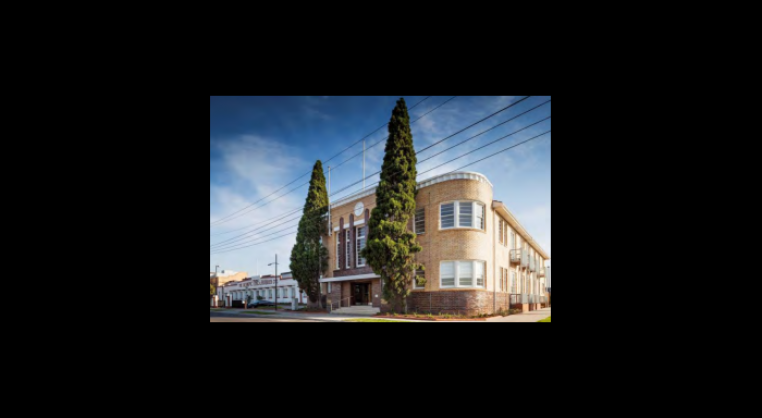Banbury Village is a large residential development of 55 apartments and townhouses on the site of the Olympic Tyre Factory in Footscray. It is named after the banbury machines, which were important in tyre production, and are now included as artefacts in the new Beaurepaire Park, located in the middle of the site.
Heritage offices and showrooms are reused to advantage as foyers, communal spaces and apartments in the new development, which was marketed in terms of its heritage qualities. The remainder of the site was cleared and accommodates medium density housing. An interpretative trail explains the site’s history, culminating in Beaurepaire Park.
Download a printable version of the Banbury Village case study (PDF 532 KB).
Site history and heritage
The large site was a tyre and rubber factory and headquarters for the Olympic Tyre Company. Established as the company headquarters in 1934, the site was expanded in 1939 and operated until 2003. Between 2003 and the beginning of the current redevelopment the site suffered constant vandalism and theft.
In 2005 Helen Lardner Conservation & Design (HLCD) completed the Conservation Management Plan (CMP). This determined the extent of the significant fabric and identified the particular importance of the Cross Street frontage. This includes a 1934 showroom in the Interwar Egyptian Revival-style, flanked by two Streamlined Moderne buildings – the Office Building, also 1934, and the Administration Building of 1939.
Although the use of Egyptian Revival is unusual, the buildings are not especially architecturally accomplished. Their importance lies in the physical link they provide to the role of the company in the industrial development of Footscray and their association with Frank Beaurepaire – an ex-Olympian and then Mayor – and his companies. Prime Minister Menzies opened the 1939 expansion and Beaurepaire was knighted the next year.
The site is listed on the City of Maribyrnong Heritage Overlay.
Opportunities
The presence of well-appointed interior spaces – particularly the Egyptian Revival showroom and the foyer of the Administration Building – is unusual in the factory context, and meant that the site had significant potential for adaptive reuse as housing.
Challenges
Contamination associated with tyre and rubber production was a major issue. Relentless vandalism had taken a significant toll – despite security, roof tiles were removed to get in and take metals, light fires and graffiti the site. Integrating the heritage components with the rest of the site development was challenging.
Approach and outcome
The CMP had established the particular significance of the Head Office interiors – the Administration Building foyer and front offices, the showroom ground floor and the interior of the production bay behind the showroom. These were retained with the balance of the site being cleared during decontamination.
The starting points identified in the CMP – including the retention of the main entries and the reuse of the Administration Building interiors as communal spaces – drove the approach to the front of the site, and were adopted as design generators by architects McGauran Giannini Soon.
The original ‘Olympic Tyre & Rubber Factory’ signage was revealed when later accretions were removed, and helped establish the project’s identity. The appearance of the site from Cross Street was important in retaining the industrial setting in the context of residential reuse. The stepped front facade of the Office Building provided opportunities for the visible insertion of contemporary elements – for example, into the loading bay and set back from the frontage at a new upper level. The forecourt was retained as hard paving – it is now used as parking – a use that is more sympathetic to the site’s industrial heritage than the alternative of landscape ‘beautification’.
Careful conservation work has enhanced the historic setting and the views to significant buildings from Cross Street. This included the partial reconstruction of the Showroom facade based on historic photographs. The pressed metal ceiling of the showroom was in very poor condition with water damage and numerous penetrations. A specialist conservator salvaged and treated the ceiling and decorative cornice, which was then reinstated within rooms of an apartment.
The outstanding spatial and decorative features of the double-height entry to the Administration Building were conserved and this has become an important shared area in the new development. This involved tricky design solutions to repair past vandalism and to achieve the required fire rating while retaining the foyer’s decorative finishes. Other Building Code of Australia requirements, including access, were achieved without compromising the heritage character of the entry to the Administration Building.
The Interpretation Plan, also by HLCD, resulted in an interpretation trail through the site culminating in Beaurepaire Park. A time capsule is buried in one of the buildings. There were some disappointments. It had been planned to retain the water tower as a landmark and a section of significant walling, but their unsafe condition meant they were demolished. Photographic archival recording was undertaken and submitted to council.
Lessons
- A good residential reuse was achieved on a former industrial site, with existing site elements and interiors being reused to advantage.
- The retention of the Cross Street streetscape is noteworthy, as is the reuse of crossovers, building entries and car parking, and the shared use of the decorative Administration Building foyer.
- The project benefitted greatly from a collaborative approach between developer, builder, heritage architect, architect and Maribyrnong Council, which was very supportive and involved throughout the process.
Project team
Architect: McGauran Giannini Soon. Conservation architect: Helen Lardner Conservation & Design. Developer: Cedar Woods. Landscape architect: MDG Landscape Architects. Builder: ABD Group. Building services: Wood & Grieve Engineers. Structural engineer: Robert Bird Group. Remediation: Senversa. Hazardous materials: Noel Arnold & Associates. Civil engineers: Urban Design and Management. Geotechnical: Golder Associates. Building Surveyor: Checkpoint Building Surveyors. Interpretive Signage: Diadem. Acoustics: Marshall Day Acoustics.



